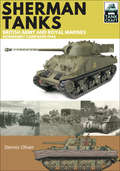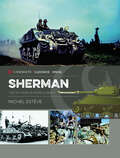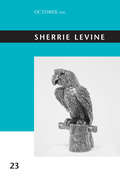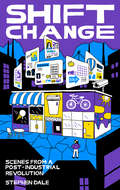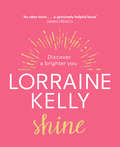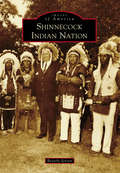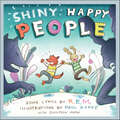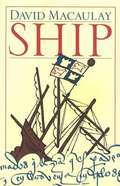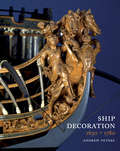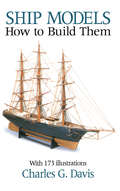- Table View
- List View
Sherlock Holmes: The Man Who Never Lived And Will Never Die
by OtherEver since his creation, Sherlock Holmes has enthralled readers. Our perception of him and his faithful companion, Dr Watson, has been shaped by a long line of film, TV and theatre adaptations. This richly illustrated book, compiled by Alex Werner, Head of History Collections at the Museum of London, is an essential guide to the great fictional detective and his world. Using the museum's unrivalled collections of photographs, paintings and original artefacts, it illuminates the capital city that inspired the Sherlock Holmes stories, in particular its fogs, Hansom cabs, criminal underworld, famous landmarks and streets. Accompanying the landmark exhibition at the Museum of London, the first since 1951, this book explores how Arthur Conan Doyle's creation of Sherlock Holmes has transcended literature and continues to attract audiences to this day. Authoritatively written by leading experts, headed by Sir David Cannadine, this thought-provoking companion sheds new light on the famous sleuth and reveals the truth behind the fiction, over 125 years after the first Sherlock Holmes story was written.
Sherman Tanks of the British Army and Royal Marines: Normandy Campaign 1944 (TankCraft)
by Dennis Oliver&“One neat book full of markings for British Shermans. It will greatly appeal to both modelers and AFV enthusiasts and historians.&”—AMPS Indianapolis With production in excess of 55,000, the Sherman tank was eventually in service with most Allied armies of the Second World War and by the time of the Normandy landings was the mainstay of Britain&’s armored battalions. In his second book in the TankCraft series, Dennis Oliver uses wartime photos and extensively researched, exquisitely presented color illustrations to cover the Sherman tanks used by the units of the Royal Armoured Corps and the Royal Marines during the fighting in northern France. As with all the books in the TankCraft series, a large part of this work showcases available model kits and aftermarket products, complemented by a gallery of beautifully constructed and painted models in various scales. Technical details as well as modifications introduced during production and in the field are also explained as is the complex system of markings employed by British armored regiments. This book will give the modeler all the information and knowledge required to recreate an authentic miniature representation of the tanks that fought from the beaches of Normandy, through the battles for Caen and on to killing fields of Falaise. &“Provides a clear overview of the Sherman tank in British service during the Normandy Campaign. This will appeal to anyone with an interest in armoured warfare and the period covered. Much Recommended.&”—Firetrench &“A good-value reference for any Sherman fan, but particularly those new to the subject and who favour &‘Blighty&’s&’ armour.&”—Airfix Model World
Sherman: The M4 Tank in World War II (Casemate Illustrated Special)
by Michel Esteve“A superbly organized, well-written, detailed history of the Sherman tank” with hundreds of photos and diagrams included (Armor Magazine).The Medium Tank, M4, better known to the British as the Sherman, was the most widely used medium tank by the United States and western Allies in World War II. Reliable, relatively cheap to produce, and easy to maintain, thousands were distributed to the British Commonwealth and the Soviet Union by the Lend-Lease program. It first saw combat in North Africa, where it outclassed lighter German and Italian tanks. By 1944 the M4 was outgunned by the German heavy tanks, but it still contributed to the fight when deployed in numbers and supported by artillery and fighter-bombers.A detailed insight into the development and deployment of the M4, this book covers the design and construction of the chassis, turret, engine, armaments, and munitions, and differences between the variants of the M4. It covers the difficulties facing the crews who fought in this legendary tank, exploring the training they received and the different combat methods perfected by the Allies, including landing from a landing craft, maneuvering in the bocage of Normandy, and fighting in the snow.Fully illustrated with hundreds of contemporary and modern photographs and detailed diagrams, this complete account provides all the technical details of the construction of the M4, its maintenance and repair, and the logistics required to support it in combat.Whether you are a collector, a modeler, or simply passionate about military history, this book will provide you with an unparalleled insight into the M4.“Period photos, preservation shots, interior details, variant schematics, archival excerpts, armament and ammunition drawings, and more . . . Make it your introduction to this legendary tank family.” —Cybermodeler
Sherrie Levine (October Files #23)
by Howard SingermanTexts—including essays, reviews, and statements by the artist—on the work of Sherrie Levine. The artist Sherrie Levine (b. 1947) is best known for her appropriations of work by other artists—most famously for her rephotographs of canonical images by Edward Weston, Eliot Porter, and other masters of modern photography. Since those works of the early 1980s, she has continued to work on and “after” artists whose names have come to define modernism, making sculpture after Brancusi and Duchamp, paintings after Malevich and Blinky Palermo, watercolors after Matisse and Miro, photographs after Monet and Cezanne as well as Alfred Stieglitz. Throughout, Levine's practice effectively uncompleted, decentered, and extended works of art that were once singular and finished, posing critical rebuttals to some of the basic assumptions of modernist aesthetics. Her work was central to the theorization of postmodernism in the visual arts—most notably as it emerged in the pages of October magazine. It challenged authorial sovereignty and aesthetic autonomy and invited readings that opened onto gender, history, and the economic and discursive processes of the art world. This collection gathers writings on Levine from art magazines, exhibition catalogs, and academic journals, spanning much of her career. The volume begins with texts by Douglas Crimp, Rosalind Krauss, and Craig Owens that situate Levine in postmodernist discourse and link her early work to October. The essays that follow draw on these first critical forays and complicate them, at once deepening and resisting them, as Levine's own work has done. All the essays attempt to understand the relationship between Levine and the artists she cites and the objects that she recasts. In these pages, Levine's oddly doubled works appear as chimeras, taxidermy, fandom, pratfalls, even Poussin's Blind Orion. Contributors Michel Assenmaker, Douglas Crimp, Erich Franz, Catherine Ingraham, David Joselit, Susan Kandel, Rosalind Krauss, Sylvia Lavin, Sherrie Levine, Maria Loh, Stephen Melville, Craig Owens, Howard Singerman
Shibata Renzaburō and the Reinvention of Modernism in Postwar Japanese Popular Literature (East Asian Popular Culture)
by Artem VorobievShibata Renzaburō and the Reinvention of Modernism in Postwar Japanese Popular Literature explores the life and work of Shibata Renzaburō (柴田錬三郎, 1917–1978), the author of adventure and historical novels who was instrumental in reinvigorating popular Japanese literature in the postwar period. This book considers postwar Japanese society through the prism of Shibata’s writing, exploring how the postwar period under SCAP Occupation influenced Shibata’s writing and generated the extraordinary popularity of samurai fiction in the postwar era at large. Through the use of a nihilistic warrior, Nemuri Kyōshirō, and other samurai characters, Shibata Renzaburō addresses important social issues of the day, such as the trauma of defeat, postwar reconstruction, and the attending societal ills and neuroses, while keeping his literature entertaining and easy to read, which ensured its mass appeal in postwar Japan.
Shibe Park/Connie Mack Stadium (Images of Sports)
by Rich WestcottNo ballpark in Philadelphia was more revered than the one atTwenty-first Street and Lehigh Avenue. Originally called ShibePark and later Connie Mack Stadium, it opened in 1909 asAmerica's first steel-and-concrete stadium. When it closed in1970, it had earned a special place in the hearts and minds ofPhiladelphia sports fans. Home of the Athletics for 46 years, thePhillies for 32 and a half seasons, and the Eagles for 18 years, itwas also the site of many boxing matches, Negro League baseballgames, and college and high school baseball and football games.Over the years, as the area developed, Shibe Park became knownfor its obstructed views, delicious hot dogs, Sunday curfews,absence of beer, and boobirds. Along with memorable teams andgames, the ballpark played host to eight World Series and twoAll-Star Games.
Shift Change: Scenes from a Post-industrial Revolution
by Stephen DaleHamilton’s industrial age is over. In the steel capital of Canada, there are no more skies lit red by foundries at sunset, no more traffic jams at shift change. Instead, an urban renaissance is taking shape. But who wins and who loses in the city’s not-too-distant future? Is it possible to lift a downtrodden, post-industrial city out of poverty in a way that benefits people across the social spectrum, not just a wealthy elite? In Shift Change, author Stephen Dale sets up “the Hammer” as a battlefield, a laboratory, a chessboard. As investors cash in on a real estate gold rush and the all-too-familiar wheels of gentrification begin to turn, there’s still a rare opportunity for both old-guard and newcomer Hamiltonians to come together and write a different story—one in which Steeltown becomes an economically diverse and inclusive urban centre for all. What plays out in these pages and at this very moment is a real-time case study that will capture the attention and the imagination of anyone interested in equitable redevelopment, housing activism, and social justice in the North American city.
Shifting Corporealities in Contemporary Performance: Danger, Im/mobility And Politics (Avant-gardes In Performance)
by Marina Gržinić Aneta StojnićThis book investigates how contemporary artistic practices engage with the body and its intersection with political, technological, and ethical issues. Departing from the relationship between corporeality and performing arts (such as theater, dance, and performance), it turns to a pluriversal understanding of embodiment that resides in the extra violent conditions of contemporary global necro-capitalism in order to conduct a thorough analysis that goes beyond arts and culture. It brings together theoretical academic texts by established and emerging scholars alike, exposing perspectives form different fields (philosophy, cultural studies, performance studies, theater studies, and dance studies) as well as from different geopolitical contexts. Through a series of thematic clusters, the study explores the reactivation of the body as a site of a new meaning-making politics.
Shifting Horizons: Women's Landscape Photography Now
by Liz WellsThroughout the history of photography the genre of landscape has been dominated by male perspectives. In this work, ten women photographers interpret the notion of landscape from a variety of perspectives.
Shifting Worlds, Shaping Fieldwork: A Memoir of Anthropology and Art
by Susan OssmanReflecting on fieldwork for the twenty-first century, anthropologist and artist Susan Ossman invites readers on a journey across North Africa, Europe, the Middle East, and North America. She reveals that fieldwork today is not only about being immersed in a place or culture; instead, it is an active way of focusing attention and engendering encounters and experiences. She conceives a new kind of autoethnography, making art and ethnography equal partners to follow three "waves" of her research on media, globalization, and migration. Ossman guides the reader through diverse settings, including a colonial villa in Casablanca, a Cairo beauty salon, a California mall-turned-gallery, the Berlin Wall, and Amsterdam’s Hermitage museum. She delves into the entanglements of solitary research and collective action. This book is a primer for current anthropology and an invitation to artists and scholars to work across boundaries. It vividly shows how fieldwork can shape scenes for experiments with multiple outcomes, from conceptual advances to artworks, performances to dialogue and community making.
Shikake: The Japanese Art Of Changing Behavior Through Design
by Naohiro MatsumuraThe Life-Changing Magic of Tidying Up meets Nudge in this irresistible design method from Japan. We are living in a time when behavioral change is necessary for our health and survival. Yet we find it exceedingly difficult to transform our own habits, let alone those of other people. Enter Naohiro Matsumura, whose powerful new design method is as astonishingly simple in its logic as it is sophisticated in its psychology. It allows any of us—from UX designers and marketers to concerned citizens and overworked parents—to address challenges in our homes, our public spaces, and our social interactions. As Matsumura shows, a shikake—or “device” in Japanese—is a design that exerts influence on us through subtle nudging, rather than direct command; it encourages a particular behavior without telling its (often unwitting) user the primary purpose of that behavior. For example: • Footprints in a store guide shoppers and keep them socially distant • A basketball hoop placed over a trash can entices children to tidy up their rooms • A symbol of a shrine in a public square encourages respectfulness • A staircase painted to look like piano keys prompts exercise through play Combining traditional Japanese aesthetics with the lessons of behavioral economics, Matsumura reveals how to identify the hidden design cues that already shape our world, and how shikakes can help us confront some of the most pressing challenges of our era, from pandemics to declining civic engagement to climate change and beyond. Mind-bending yet elegant, Shikake presents a tool kit for anyone who wants to create their own mindful designs, for the delight and betterment of us all.
Shimmer and Shine Workshop: Create Art That Sparkles
by Christine AdolphMake Art That Sparkles!Shimmer and Shine Workshop introduces 30+ step-by-step art tutorials for adding a little (or a lot!) of shine to your mixed-media art. No matter what your experience level, you will love exploring numerous ways to use transfer foil, metallic inks, paints and other mediums as you explore projects for art journaling, gift-giving, home decor and more.Tips for getting more mileage from each sheet of transfer foilMethods for working with and without heatTechniques for creating on a variety of surfaces—paper, wood, fabric, glass and moreBeautiful art to keep you inspired!Learn how easy it is to let your art shine! Shimmer and Shine Workshop lights the way!
Shimmering Images: Trans Cinema, Embodiment, and the Aesthetics of Change
by Eliza SteinbockIn Shimmering Images Eliza Steinbock traces how cinema offers alternative ways to understand gender transitions through a specific aesthetics of change. Drawing on Barthes's idea of the “shimmer” and Foucault's notion of sex as a mirage, the author shows how sex and gender can appear mirage-like on film, an effect they label shimmering. Steinbock applies the concept of shimmering—which delineates change in its emergent form as well as the qualities of transforming bodies, images, and affects—to analyses of films that span time and genre. These include examinations of the fantastic and phantasmagorical shimmerings of sex change in Georges Méliès's nineteenth-century trick films and Lili Elbe's 1931 autobiographical writings and photomontage in Man into Woman. Steinbock also explores more recent documentaries, science fiction, and pornographic and experimental films. Presenting a cinematic philosophy of transgender embodiment that demonstrates how shimmering images mediate transitioning, Steinbock not only offers a corrective to the gender binary orientation of feminist film theory; they open up new means to understand trans ontologies and epistemologies as emergent, affective, and processual.
Shine (Shine)
by Jessica JungCrazy Rich Asians meets Gossip Girl by way of Jenny Han in this knock-out debut about a Korean American teen who is thrust into the competitive, technicolor world of K-pop, from Jessica Jung, K-pop legend and former lead singer of one of the most influential K-pop girl groups of all time, Girls Generation. <P><P>What would you give for a chance to live your dreams? For seventeen-year-old Korean American Rachel Kim, the answer is almost everything. Six years ago, she was recruited by DB Entertainment—one of Seoul’s largest K-pop labels, known for churning out some of the world’s most popular stars. The rules are simple: Train 24/7. Be perfect. Don’t date. Easy right? Not so much. <P><P> As the dark scandals of an industry bent on controlling and commodifying beautiful girls begin to bubble up, Rachel wonders if she’s strong enough to be a winner, or if she’ll end up crushed… Especially when she begins to develop feelings for K-pop star and DB golden boy Jason Lee. It’s not just that he’s charming, sexy, and ridiculously talented. He’s also the first person who really understands how badly she wants her star to rise. <P><P>Get ready as Jessica Jung, K-pop legend and former lead singer of Korea’s most famous girl group, Girls Generation, takes us inside the luxe, hyper-color world of K-pop, where the stakes are high, but for one girl, the cost of success—and love—might be even higher. It’s time for the world to see: this is what it takes to SHINE. <P><P><b>A New York Times Bestseller</b>
Shine: Discover a Brighter You
by Lorraine Kelly'This is an utter tonic. Lorraine at her most honest; a genuinely helpful book' DAWN FRENCH'I love this book!' DAVINA MCCALL________________________________Lorraine has been a fixture on our TV screens for 35 years and is beloved by thousands for her warmth and down-to-earth interviewing style. Whatever life throws at her, she always manages to keep that signature twinkle in her eye. Now, she's ready to share her life lessons.There's a lot to keep up with nowadays: family, home, work, social media, the news... It's all too easy for days go by in a blur and before you know it, you're exhausted and the year has passed in the blink of an eye. Despite her hectic schedule, Lorraine has learned how important it is to listen to your body and your heart, and to take control of your life. Whether making small changes to your daily routine or overhauling your lifestyle and achieving those bucket-list goals, Shine will show you how to live every day to the fullest. Let Lorraine guide you on the journey to your best self with candid anecdotes from her own life, tips from the experts and practical exercises. You'll learn how to:- Spark: how to stay positive, confident and calm whatever life throws at you.- Glow: encouragement and strategies for keeping your body healthy and your look fresh, whatever your age.- Dazzle: how to get the best out of your relationships, family and work and make a difference to the world, even if it's just your patch.Uplifting, warm, and with beautiful hand-painted illustrations, Shine is a self-help book told from the heart.
Shine: The Visual Economy of Light in African Diasporic Aesthetic Practice
by Krista A. ThompsonIn Jamaican dancehalls competition for the video camera's light is stiff, so much so that dancers sometimes bleach their skin to enhance their visibility. In the Bahamas, tuxedoed students roll into prom in tricked-out sedans, staging grand red-carpet entrances that are designed to ensure they are seen being photographed. Throughout the United States and Jamaica friends pose in front of hand-painted backgrounds of Tupac, flashy cars, or brand-name products popularized in hip-hop culture in countless makeshift roadside photography studios. And visual artists such as Kehinde Wiley remix the aesthetic of Western artists with hip-hop culture in their portraiture. In Shine, Krista Thompson examines these and other photographic practices in the Caribbean and United States, arguing that performing for the camera is more important than the final image itself. For the members of these African diasporic communities, seeking out the camera's light--whether from a cell phone, Polaroid, or video camera--provides a means with which to represent themselves in the public sphere. The resulting images, Thompson argues, become their own forms of memory, modernity, value, and social status that allow for cultural formation within and between African diasporic communities.
Shinnecock Indian Nation (Images of America)
by Beverly JensenThe Shinnecock have resided along the shores of eastern Long Island for more than 10,000 years. These hunter-gatherers were also skilled whalers who first tackled the Atlantic in their dugout canoes and later became highly regarded crew members on 19th-century whaling ships that sailed the globe. The Shinnecock were also noted wampum makers, using the northern quahog hard-shelled clam and whelk shells to craft some of the finest-quality wampum beads to be found anywhere along the eastern seaboard. Since the first tall ships sailed into the local waters in the 1500s, new settlers and shifty land deals have diminished the ancestral territory of the Shinnecock Indian Nation. Despite overwhelming odds, however, and in the midst of immense privilege and wealth of their Hamptons neighbors, the Shinnecock remain. They are a federally recognized tribe with more than 1,500 enrolled members and are governed by a seven-member council of trustees.
Shinto the Kami Way
by Sokyo Ono William WoodardShinto, the indigenous faith of the Japanese people, continues to fascinate and mystify both the casual visitor to Japan and the long-time resident. This introduction unveils Shinto's spiritual characteristics and discusses the architecture and function of Shinto shrines. Further examination of Shinto's lively festivals, worship, music, and sacred regalia illustrates Shinto's influence on all levels of Japanese life.Fifteen photographs, numerous drawings and Dr. Ono's text introduce the reader to two millenia of indigenous Japanese belief in the Kami - the sacred spirits worshipped in Shinto - and in communal life, the way of the Kami.
Shiny Happy People: A Children's Picture Book (LyricPop #0)
by R.E.M. ShinYeon MoonR.E.M.'s hit song is brought to life in this joyful picture book celebrating friendship and togetherness.“In this picture-book adaptation of R.E.M.’s song, a young fox and rabbit show the adults that everyone can be friends . . . A pop song finds new life as a simple yet heartfelt story of acceptance.” —Kirkus Reviews"Shiny happy people laughing Everyone around, love them, love them Put it in your hands, take it, take it There's no time to cry, happy, happy . . ." Shiny Happy People is a heartwarming picture book whose story is told through the lyrics of R.E.M.'s joyful tune of the same name. "Shiny Happy People" appeared on the band's 1991 album Out of Time, and the song reached the top 10 of the Billboard Hot 100 chart. With lyrics by R.E.M. and illustrations by Paul Hoppe, this picture book follows the unlikely friendship between a rabbit and a fox as they teach others about the joy of inclusion and acceptance. It is the perfect vehicle for R.E.M. fans to share a loving and positive message with children of all ages.
Shiny and New: Ten Moments of Pop Genius that Defined the '80s
by Dylan JonesThe Eighties were about big ideas writ large - new money, new style, gender fluidity, gay pride, attritional politics, the 'special relationship', nuclear fear, AIDS, cocaine, ecstasy, tabloid royalty, the rise of urban pop, and ultimately geopolitical chaos. Using a big narrative approach, Dylan Jones' history of the decade in pop frames the decade through some of its most important and popular hits, choosing records which either epitomised their time, or ushered in a new cultural shift. So we move seamlessly from Rapper's Delight and the genre defining moment of hip hop into The Specials' spectral, Ghost Town; from ABC and the apotheosis of New Pop (The Look of Love) to Madonna's breakthrough moment with Like a Virgin, and so on. In the '80s each year brought a new twist as technology shifted and genres snowballed, MTV reigned supreme and the story of pop became globalised. It was a decade of excess in all areas, especially ambition, but it was in the transcendent moments of pop perfection that the '80s found its true art-form. Subjective and idiosyncratic, SHINY AND NEW takes us from downtown New York to post-industrial Manchester, in the first widescreen attempt to weave together the stories, the songs and events that re-shaped music and society.
Shiny and New: Ten Moments of Pop Genius that Defined the '80s
by Dylan JonesThe Eighties were about big ideas writ large - new money, new style, gender fluidity, gay pride, attritional politics, the 'special relationship', nuclear fear, AIDS, cocaine, ecstasy, tabloid royalty, the rise of urban pop, and ultimately geopolitical chaos. Using a big narrative approach, Dylan Jones' history of the decade in pop frames the decade through some of its most important and popular hits, choosing records which either epitomised their time, or ushered in a new cultural shift. So we move seamlessly from Rapper's Delight and the genre defining moment of hip hop into The Specials' spectral, Ghost Town; from ABC and the apotheosis of New Pop (The Look of Love) to Madonna's breakthrough moment with Like a Virgin, and so on. In the '80s each year brought a new twist as technology shifted and genres snowballed, MTV reigned supreme and the story of pop became globalised. It was a decade of excess in all areas, especially ambition, but it was in the transcendent moments of pop perfection that the '80s found its true art-form. Subjective and idiosyncratic, SHINY AND NEW takes us from downtown New York to post-industrial Manchester, in the first widescreen attempt to weave together the stories, the songs and events that re-shaped music and society.
Ship
by David MacaulayIn Ship we join a group of underwater archaeologists as they search for a long-lost caravel in the reefs of the Caribbean Sea. A combination of drawings, maps, and diagrams details the ship's recovery, and as clues to the past are pieced together, a story emerges - of the triumphant birth of the ship Magdalena from Spain, and its tragic voyage to a far-away continent.
Ship Decoration, 1630–1780: 1630-1780
by Andrew PetersThis book is a detailed comparative study of the decorative work figurehead, topside ornamentation and stern gallery design carried by the ships of the major maritime states of Europe in the zenith of the sailing era. It covers both warships and the most prestigious merchant ships, the East Indiamen of the great chartered companies. The work began life in the year 2000 when the author was commissioned to carry out research for an ambitious project to build a full-size replica of a Swedish East Indiaman, which produced a corpus of information whose relevance stretched way beyond the immediate requirements of accurately decorating the replica.In tracking the artistic influences on European ship decoration, it became clear that this was essentially the story of the baroque style, its dissemination from France, and its gradual transformation into distinct national variations in Britain, the Netherlands, Denmark and Sweden. It is an inherently visual subject and the book illustrates developments with numerous photographs of contemporary ship models, paintings and plans, as well as the author's own interpretive illustrations of details.As the first major work on the topic for nearly a century, it will be of obvious appeal to ship modellers and historians, but with comparative examples drawn from architecture and sculpture, it also makes a broader contribution to the history of the applied arts.
Ship Dioramas: Bringing Your Models to Life
by David GriffithThe author of Ship Models from Kits &“has brought nautical scenes to life in his latest book&” (Daily Record). This book is about the art of displaying waterline models. By their very nature, ship models that do not show the full hull and are not mounted on an artificial stand cry out for a realistic setting. At its most basic this can be just a representation of the sea itself, but to give the model a context to tell some sort of story is far more challenging. In a diorama, the composition is a vital element and this book devotes much of its space to what works and what does not—and illustrates with photographic examples why the best maritime dioramas have visual power and how to achieve that impact. Individual chapters explore themes like having small craft in attendance on the main subject, multiple-model scenarios, dockyards and naval bases, and the difficulties of replicating naval combat realistically. It also looks at both extremes of modelmaking ambition: the small single-ship exposition and the largest, most ambitious projects of the kind meant for museum display. The book concludes with some of the most advanced concepts of how to create drama and the illusion of movement, and how to manipulate perspective. David Griffith&’s book is &“compelling and inspiring . . . littered with practical examples of work in progress, simple dioramas to the most complex . . . I highly recommend it to all ship modellers without hesitation&” (Scale Modelling Now).
Ship Models: How to Build Them (Dover Woodworking)
by Charles DavisComplete, step-by-step instructions for building schooners, galleons, clipper ships, more. Includes scale plans for 1846 clipper ship Sea Witch. Excellent guide for both the novice and the practiced woodworker — from the first steps in selecting proper materials to final task of painting the model. Over 150 photographs.

